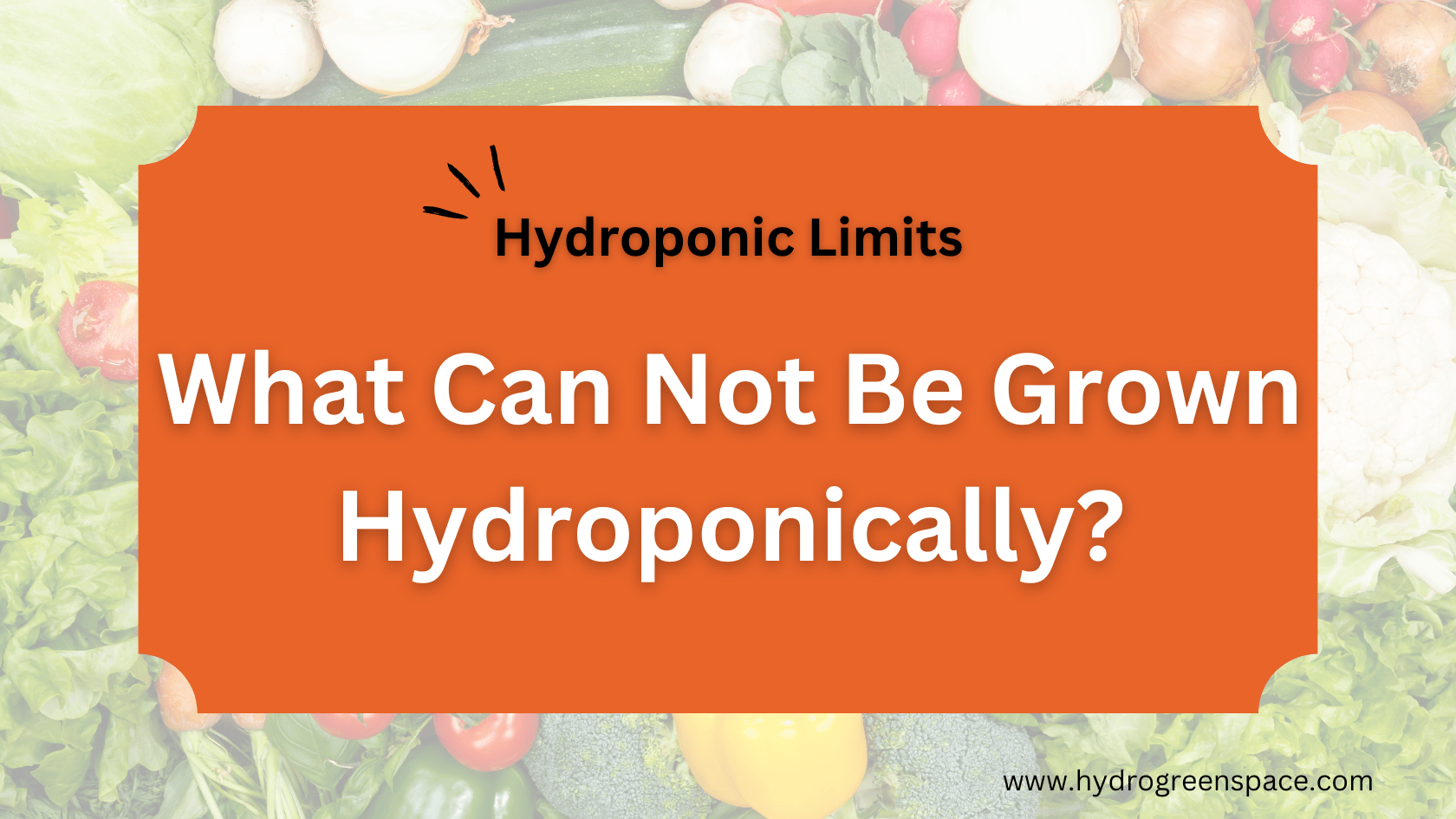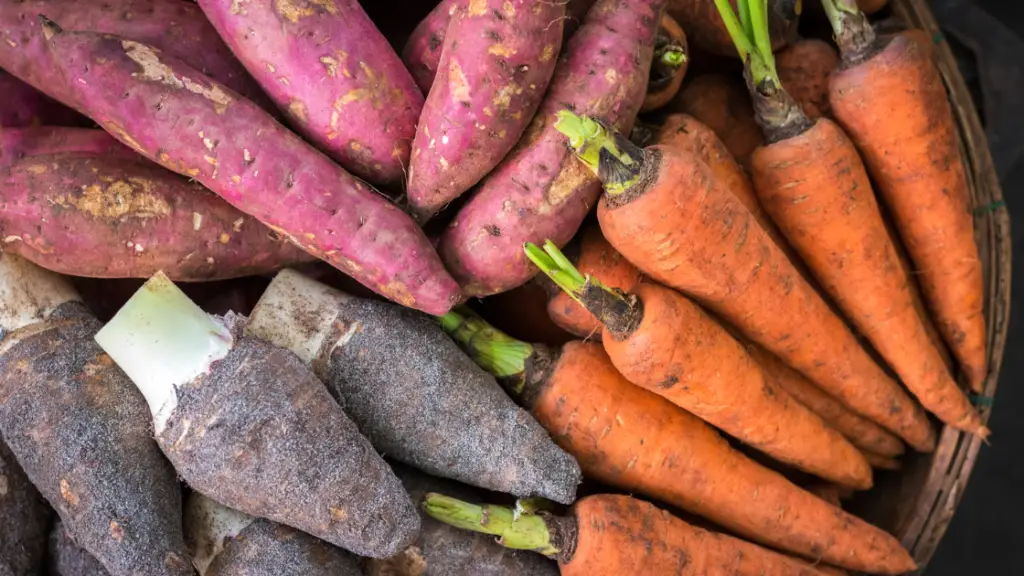Hydroponic Limits – What Can Not Be Grown Hydroponically?

As a busy professional living in a small urban apartment, I developed a passion for gardening when I discovered hydroponics – the method of growing plants without soil by using nutrient-rich water solutions.
I was fascinated by the prospect of maximizing my limited space to grow herbs, veggies, and fruit. However, a friend recently asked me if all plants can thrive hydroponically or if some crops are better suited to traditional in-ground gardening. This got me thinking about the limitations of hydroponic gardening.
I started researching which plants may not do so well when soil is taken out of the equation. While hydroponics offers many benefits like faster growth, higher yields, and less water usage for some crops, it poses some challenges for others.
As I discovered, factors like a plant’s root structure, growth habits, climate preferences, and nutrient needs can influence how well it will adapt to a soil-free setup. Additionally, space constraints, lighting conditions, and pest susceptibility in enclosed hydroponic systems may limit yields for some fruits and vegetables.
In this blog post, I’ll share some of the most challenging crops to grow hydroponically based on my research. I’ll also discuss techniques you can experiment with to push the boundaries of what’s possible using different hydroponic configurations.
While hydroponics may not be ideal for ALL produce, it opens up innovative growing potential in small indoor and urban spaces. Let’s explore some limitations and considerations when selecting crops to get the most out of a home hydroponic garden.
Table of Contents
Plants that Strongly Prefer Soil Environments
Some crops strongly prefer growing in actual soil and can be tricky to cultivate hydroponically. Here are a few examples of plants that thrive best with their roots in soil:
- Carrots: Carrots develop large taproots that drive down to absorb nutrients. Hydroponic carrots often end up stunted or misshapen without deep soil to burrow into. However, some gardeners have had success using deep-water culture systems.
- Sweet Potatoes: Like carrots, sweet potatoes form tuberous roots that have difficulty properly expanding in confined hydroponic systems.
- Peanuts: Peanuts need the ideal light, and porous soil composition to properly develop. This is hard to mimic hydroponically.

While taprooted crops present challenges, don’t give up completely. You can try experimenting with different hydroponic techniques like:
- Aeroponics: Suspends plant roots in the air and mists them with a nutrient solution.
- Deep water culture: Allows taproots to extend down into the nutrient reservoir.
PS: You have to know that these crops will likely never grow as vigorously without soil.
Space-Intensive Fruiting Crops
Certain fruiting crops require ample space for sprawling vine growth, making them challenging for compact hydroponic systems. Some examples include:
- Melons: Melons produce long trailing vines that spread out as the fruits develop. Limited vertical and horizontal space in hydroponics can restrict growth.
- Squash: Zucchini, pumpkin, and winter squash grow on spreading vines that can exceed 10+ feet in soil gardens. Hard to accommodate in small hydroponic setups.
- Cucumbers: Cucumber vines are also prolific spreaders that need room to expand, especially for larger slicing varieties.
The extensive vines and large leaves of these crops can quickly overrun a hydroponic system intended for smaller plants. However, there are some techniques you can try to grow them hydroponically:
- Trellising and pruning: Training vines upward and trimming overgrowth forces plants to grow vertically, saving space.
- Smaller varieties: Choose compact, bush-type cultivars suitable for containers.
- Larger systems: Expand your hydroponic setup with longer channels or beds to accommodate growth.
While still a challenge, don’t rule out growing melon and squash hydroponically. With the right equipment and training, you can find success producing these sprawling fruiting vines.
Heavy-Feeding Crops
Some plants need abundant nutrients and can quickly deplete hydroponic systems. Examples of heavy feeders include:
- Corn: Requires high levels of nitrogen for full ear development.
- Broccoli: Depends on constant access to calcium, magnesium, and sulfur.
- Cabbage: Like broccoli, needs steady nutrient flow for heads to form.
- Other brassicas: Cauliflower, kale, and Brussels sprouts also feed heavily.
Growing these crops hydroponically requires diligent solution monitoring:
- Test nutrient levels frequently. Adjust minerals regularly to prevent deficiencies.
- Provide more space per plant than lighter feeders need.
- Keep a consistent flow of fresh solutions to satisfy demand.
- Use a reservoir size that allows for rapid replenishment.
While demanding, heavy feeders can succeed hydroponically with:
- Careful solution management and testing
- Adequate root zone and reservoir capacity
- Precise environmental controls and plant spacing
Prioritize plant nutrition and system design for best results with extra-hungry crops.
Cold-Climate Crops
Some plants thrive in colder conditions that are difficult to maintain year-round in indoor hydroponic systems. Examples of crops that prefer cooler climates include:
- Asparagus: Goes dormant in high temperatures above 85°F.
- Rhubarb: Needs consistent winter chilling for best flavor and stalk growth.
- Artichokes: Require cool weather and can bloom poorly in hot conditions.
- Fava beans: Grow best with temps in the 60s. Heat causes flowers to drop.
- Brussels sprouts: Flavor improves after exposure to frost.
To grow these cool-weather loving plants hydroponically, you’ll need specialized solutions:
- Heated water systems: Use a chiller to keep nutrient water in optimal temp range.
- Cool-weather greenhouses: Maintain ideal ambient conditions in unheated structures.
- Delayed planting schedules: Start crops in late fall/early spring to match natural seasons.
With extra equipment or planning, it is possible to mimic cooler climates for crops like asparagus that need a winter rest period or plants that thrive in frost. However, maintaining ideal temperatures year-round can be an energy-intensive challenge.
Nutrient Accumulating Crops
Some plants absorb and accumulate high levels of specific minerals from the water solution. Examples include:
- Ginseng: Can over-absorb minerals like iron, calcium, magnesium, and phosphorus.
- Goldenseal: Also prone to accumulating excess amounts of some nutrients when grown hydroponically.
- Mint: Known to readily take up abundant quantities of manganese.
- Basil: Boron levels can build up to toxic concentrations in hydroponic basil.
- Rosemary: Can absorb sodium and chloride, resulting in foliar burn.
Growing these crops in hydroponics requires close monitoring of solution levels:
- Test nutrient solution frequently to catch excess mineral absorption.
- Modify formulas to limit the availability of easily accumulated nutrients.
- Ensure proper pH balance since uptake is pH-dependent.
- Use controlled techniques like aeroponics to manage absorption.
- Flush systems regularly to prevent dangerous toxicity levels.
While a challenge, nutrient accumulators can thrive hydroponically with careful solution management and controlled nutrient dosing tailored to the specific plants.
Disease/Pest Susceptibility
The enclosed environments of hydroponic systems can increase risks for certain diseases and pests. Some susceptible crops include:
- Tomatoes: Prone to fusarium, verticillium, tobacco mosaic virus, and other diseases in humid indoor conditions.
- Peppers: Also affected by fungal issues like phytophthora blight in damp hydroponic setups.
- Cucumbers: Highly vulnerable to powdery mildew spores circulating in greenhouses.
To prevent crop-damaging outbreaks, focus on maintenance and pest management:
- Disinfect system components and use a sterile seed starting mix.
- Allow for adequate air circulation and dehumidification.
- Treat nutrient solutions to eliminate pathogens.
- Monitor for early signs of infestations and treat them promptly.
- Keep the greenhouse interior clear of weeds and debris.
- Rotate plantings to limit disease carryover between crops.
Proper design, sanitation, and maintenance habits are key to avoiding disastrous pest and disease scenarios. With preventative care, susceptible fruits and vegetables can thrive hydroponically.
Pollination Challenges
Some fruiting crops rely on insect pollination and require assistance in enclosed hydroponic settings. Examples include:
- Squash: Requires bees or other pollinators to carry pollen from male to female blooms.
- Cucumbers: Also need pollen transfer between flowers for fruit development.
- Eggplants: Depend on pollinators to set fruits.
- Peppers: Benefit from insect pollination for maximum yields.
To successfully produce these crops hydroponically, you’ll need to intervene with pollination:
- Introduce bumblebees or other approved pollinators if allowed.
- Manually pollinate by collecting pollen and dabbing onto flowers.
- Use air circulation fans to simulate natural pollen transfer.
- Tap or vibrate flowering stems to disperse pollen.
With greenhouse conditions limiting natural pollinators, techniques like manual pollination, plant vibration, or introduced bees can ensure a proper fruit set. A little hands-on help can go a long way for pollinator-dependent food crops.
Yield and Harvest Considerations
While capable of growing hydroponically, some crops tend to produce lower yields than in traditional in-ground farming. For example:
- Potatoes: Often limited in size and quantity compared to soil-grown tubers.
- Carrots: Hydroponic roots may be smaller and knobbier without deep soil.
- Beets: Restricted root development can limit bulb size and formation.
- Tomatoes: More prone to issues like blossom drop, reducing fruit quantities.
There are some strategies to potentially boost productivity:
- Optimize timing – start plants when systems have optimal light and temperatures.
- Manage nutrient solutions diligently – ensure no deficiencies limit growth.
- Allow adequate root zone space for expansion.
- Use trellising/training methods to support and maximize plant growth.
- Compare different setups (NFT, deep water, etc.) to determine the best system.
While hydroponic yields may not match field farming, you can still achieve respectable harvests with careful management. Test different techniques to learn how to optimize your specific crops and conditions.
In conclusion, even though hydroponic gardening offers many benefits, some crops present distinct challenges without the support of an in-ground soil environment. Plants with extensive roots, spreading vines, heavy nutrient demands, or specific climate preferences may not reach their full potential.
However, techniques like careful nutrient solution management, controlled environments, trellising, and pollination assistance can extend the possibilities of hydroponics. With extra consideration for plant specifics and system design, it may be possible to achieve reasonable success growing unconventional produce hydroponically.
Don’t let limitations deter you from experimenting with new crops. Part of the fun is discovering which unlikely plants you can coerce into thriving with the right hydroponic innovations. For any challenging specimens, research crop-specific growing tips from experienced hydroponic gardeners. With persistence and ingenuity, you may be surprised just how much your home system can produce.
Now that we’ve explored some of the boundaries, it’s time to envision what lies beyond the traditional confines of hydroponics and grow!

